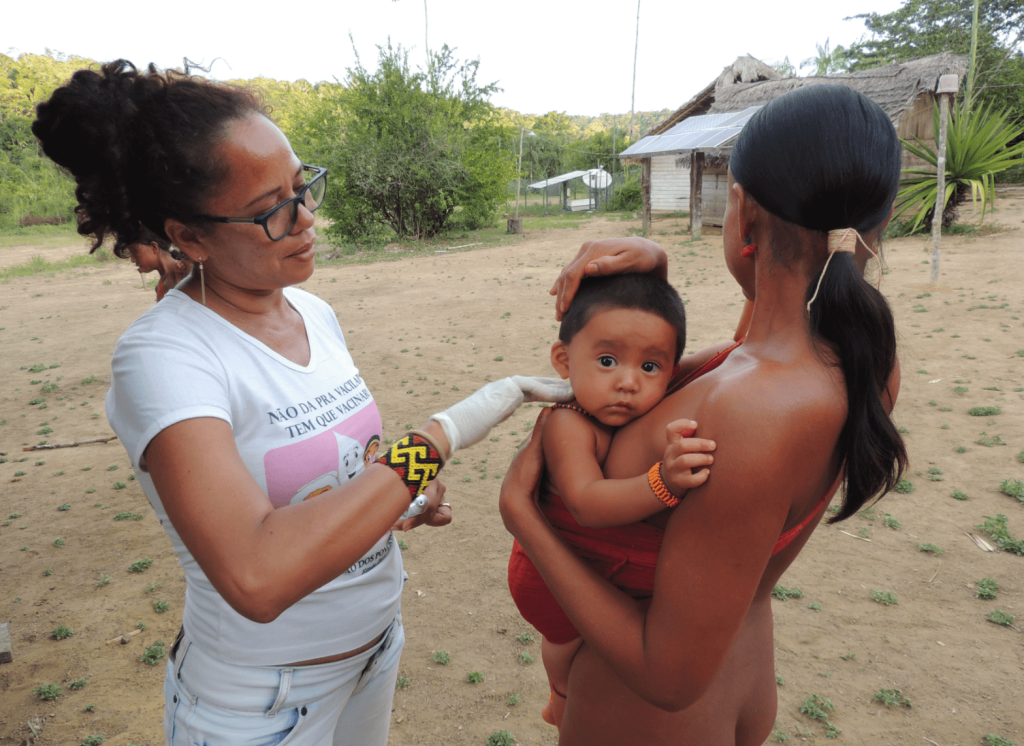HEALTH STATUS AND VULNERABILITIES

Zoé health care. Photo: SESAI/Ministry of Health
Network of insecurities
High incidence of infectious diseases and little information about diagnoses increase the risk of mortality and health maladjustments
In general, the health indicators of indigenous peoples in the Amazon tend to be worse than the national averages. High rates of infant and maternal mortality and high prevalence of diarrheal diseases, upper respiratory diseases, malaria, helminthiasis, tuberculosis, viral hepatitis (HDB and HDV) and leishmaniasis are some of the diseases with higher frequency. The infectious diseases that most frequently affect the indigenous population also present the highest mortality risk among them, especially in children. The historical persistence of high prevalence of infectious diseases, besides representing an indicator of the living conditions and environmental protection, expresses inequities in relation to the non-indigenous society.
Another important factor observed in the studies was the difficulty in obtaining health data that reflect the real situation of indigenous health. This is because in most countries the information systems were not designed to include the category “indigenous” in the epidemiological surveillance instruments, or because there is no monitoring of the health care flows of the indigenous population. Brazil is the only country that has an information system that gathers data on the health of the indigenous population. Even so, a considerable portion of the records cannot be evaluated due to lack of diagnosis. Such factors show difficulties in identifying biomedical causality in the set of pathologies indicated as most frequent in the population, besides expressing the fragility in the practice of intercultural health in such a heterogeneous ethnic context.
The absence of diagnoses also expresses the regional characteristic of difficult access to laboratory networks, hospitals, and specialized clinics. Besides the lack of diagnostic technologies for complementary exams, the Amazon region lacks protocols and training that allow health teams to better identify certain diseases that affect the population but remain unrecorded. Moreover, the territorial dispersion added to the low frequency of primary care follow-up in some localities has contributed to the persistence of pathologies that can be identified and treated clinically, such as syphilis and congenital syphilis, tuberculosis, parasitosis, mycoses, and especially perinatal diseases.
Besides the effects of the disease on people, the fragility of primary care must also be dimensioned in its family and social impact. There is a set of pathologies that are only diagnosed in their most serious conditions as in the case of malnutrition, alcohol and drug abuse, and family, community, and interethnic violence. This picture reflects multiple vulnerabilities related to historical and contemporary processes of colonization and inequity in health that bring other consequences such as malnutrition, low life expectancy, and changes in eating habits.
The peoples in isolation and initial contact, in particular, present even greater vulnerability. In relative isolation and with assured territorial integrity, these populations maintain a stable relationship with infectious disease agents present in their environment, in a state of equilibrium and demographic growth. Since there is no immunological memory against infectious agents that are common to the majority national population, nor active immunization through vaccination, when coming into contact with surrounding populations, epidemic outbreaks can occur in the group, which can lead to high mortality from infectious diseases.
MAPA INTERATIVO
Observe no mapa interativo do Módulo Povos Indígenas, onde se localizam os territórios indígenas na região amazônica e observe as regiões fronteiriças estudadas pelos consultores da OTCA:
